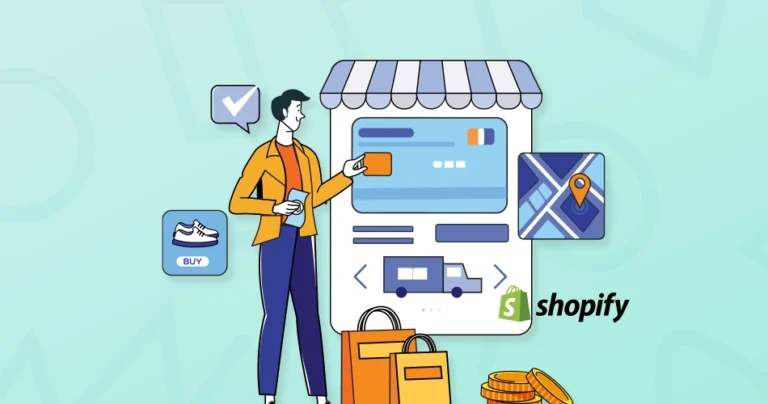A smooth checkout process can make or break a Shopify store’s conversion rates. A shopper might abandon cart if there are too many unnecessary fields or limited payment options. That will cost your business valuable sales.
You can, of course, customize checkout in Shopify, which isn’t just about aesthetics. You need to reduce friction, build trust, and guide customers to completion. This customization includes everything from editing fields to enabling express payments.
This guide covers actionable steps to optimize your checkout flow while adhering to Shopify’s customization protocols. Let’s begin.
Why Customize the Checkout Flow in Shopify?
One of the best ways to reduce cart abandonment is to optimize the checkout. Every customer expects speed, simplicity, and security. But if your store, especially the checkout flow, feels clunky or untrustworthy in any way, the customers will switch to the next alternative.
Customizing Shopify’s checkout will let you:
- Reduce Friction: Eliminate unnecessary fields, enable autofill, and offer guest checkout to speed up purchases.
- Increase Trust: Add secure payment badges, order summaries, and clear return policies to reassure buyers.
- Boost Conversions: Features like one-click upsells, localized shipping options, and saved payment methods encourage faster decisions.
- Improve Branding: While Shopify limits design changes, subtle tweaks like custom thank-you pages reinforce your store’s identity.
All in all, optimizing the checkout won’t just be about the aesthetics. You will need to remove the barriers that cost you sales. For that, you can hire Shopify developers with us.
How to Customize Checkout in Shopify?
A seamless checkout experience can significantly reduce cart abandonment and increase conversions. Shopify’s checkout is designed for speed and security. But you can still optimize it within platform guidelines.
One-page Checkout
A multi-step checkout can frustrate shoppers and increase abandonment. Shopify’s one-page checkout consolidates all fields—shipping, billing, and payment—into a single, streamlined view. This reduces clicks, speeds up purchases, and minimizes distractions.
To optimize further, remove unnecessary fields and enable autofill for returning customers.
Guest Checkout
Forcing account creation is a major conversion killer. Offering guest checkout lets first-time buyers skip sign-ups and complete purchases faster. You can still capture their email for follow-ups. It can also help gently encourage account creation post-purchase with incentives like order tracking or loyalty rewards.
Checkout Customer Support
Last-minute doubts can derail a sale. Embedding live chat, a help button, or a FAQ link directly in the checkout reassures hesitant buyers. Quick answers to shipping or return questions reduce hesitation and build trust right when it matters most.
Cross-sell Products
Strategic upsells at checkout can increase average order value (AOV), one of the key eCommerce metrics. Shopify apps allow you to suggest complementary products (e.g., “Add a case for 15% off”) before payment. Keep offers relevant and non-intrusive—too many pop-ups can backfire.
Loyalty Points Program
Reward returning customers by setting up an eCommerce loyalty program. Let them redeem points at checkout. Displaying available discounts (“You have 500 points—$10 off!”) incentivizes immediate purchases and encourages repeat visits. Apps like Smile.io or LoyaltyLion integrate seamlessly with Shopify.
Checkout Social Proof
There’s a chance some of the customers will still have some doubts. So add trust badges (like “10,000+ happy customers”) or real-time purchase notifications (“Someone just bought this!”). That will effectively reduce buyer hesitation. Using social proof validates their decision, making them more likely to complete checkout.
BOPIS Checkout
It’ll be a great idea to offer local pickup if you want to speed up fulfillment and cut shipping costs. Highlight BOPIS at checkout with clear pickup location options and estimated ready times. This appeals to impatient shoppers and boosts foot traffic for brick-and-mortar stores.
Buy Now, Pay Later
Flexible payment options like Klarna, Afterpay, or Shopify Pay Installments make high-ticket purchases more manageable. Displaying installment pricing (e.g., “4 interest-free payments of $25”) can significantly improve conversion rates.
Shipment Delay Notification
Transparency builds trust. If there are shipping delays, proactively notify customers at checkout with a brief disclaimer (“Ships in 5-7 days due to high demand”). This sets realistic expectations and reduces post-purchase complaints.
Free Shipping
Nothing motivates buyers like free shipping. Set a minimum spend (e.g., “Free shipping on orders over $50”) and display a progress bar (“Spend $10 more for free shipping!”). This tactic often increases AOV as customers add extra items to qualify.
SMS/Email Opt-in at Checkout
Turn one-time buyers into repeat customers by capturing their contact info. A simple checkbox (“Get order updates via SMS”) or post-purchase pop-up (“Subscribe for 10% off”) helps grow your marketing list while providing value.
Checkout Live Chat
A last-minute question or query shouldn’t cost you a sale. Integrating live chat or chatbot support directly in the checkout flow helps address concerns in real time—keeping shoppers from leaving to seek answers elsewhere.
Each of these tweaks can refine your checkout experience. So consult with our professional Shopify development company to make sure of the best results.
Best Practices for Shopify Checkout Customization
Shopify’s checkout is already optimized for speed, but strategic tweaks can further reduce friction and increase sales. Follow these data-backed practices to refine the checkout experience for your customers while staying within Shopify’s limits.
Minimize Form Fields
Only ask for essential info. Auto-fill where possible. Fewer fields = faster checkout. Remove unnecessary questions that could frustrate buyers and lead to cart abandonment.
Enable Guest Checkout
Don’t force account creation. Let customers check out as guests. Offer an optional sign-up post-purchase with incentives like order tracking or discounts.
Offer Multiple Payment Options
Accept credit cards, PayPal, Apple Pay, and BNPL (like Klarna). More choices = fewer drop-offs. Display popular payment icons to build trust.
Display Trust Signals
Add security badges, money-back guarantees, and SSL seals. Show customer reviews or purchase notifications to ease doubts before payment.
Optimize for Mobile
Over 70% of Shopify traffic is mobile. Ensure buttons are thumb-friendly, form auto-zoom, and pages load fast. Test on real devices.
Set Clear Shipping Costs Early
Avoid sticker shock. Show shipping fees on product pages or cart—not just at checkout. Offer free shipping thresholds to boost AOV.
Add Urgency & Scarcity
Use low-stock alerts (“Only 3 left!”) or countdown timers (“Free shipping ends in 30 min”). Creates FOMO without being pushy.
Post-Purchase Upsells
After payment, offer related products or upgrades with one-click add-ons. Works best when paired with discounts (“Add this for 15% off”).
Streamline Returns & Policies
Link to a clear, concise return policy at checkout. No hidden fees. Easy returns = more confident buyers. Consider free return shipping.
Make sure to iterate with changes and test them with A/B tools like Optimizely to see what boosts conversions for YOUR audience.
Let’s Summarize
A well-customized checkout isn’t just about aesthetics. You need to remove friction, build trust, and guide customers smoothly to completion. It’s important to implement strategic tweaks like one-page checkout, guest checkout options, trust signals, and mobile optimization. That way, you can significantly reduce cart abandonment and boost conversions.
Remember: Every second counts. The fewer obstacles shoppers face, the more likely they are to complete their purchase. Test different approaches, track performance, and refine your checkout flow based on real customer behavior. So, want help with customizing the checkout? Then consult with our experts today!
FAQs on Shopify Checkout Customization
Q1. Does Shopify allow customization?
Yes, but with limitations. Shopify Plus merchants can edit the checkout’s HTML/CSS, while regular stores can tweak fields, colors, and logos via the checkout editor.
Q2. Can I fully customize Shopify’s checkout design?
No—Shopify restricts deep design changes to ensure speed and security. However, you can adjust colors, fonts, and layout elements if you’re on Shopify Plus.
Q3. Are checkout upsells allowed in Shopify?
Not directly in the native checkout, but apps like ReConvert enable post-purchase upsells on the thank-you page without breaking Shopify’s rules.
Q4. How can I make checkout mobile-friendly?
Stick to Shopify’s default mobile-optimized checkout, minimize form fields, and enable fast payment options like Apple Pay or Shop Pay for one-tap purchases.





